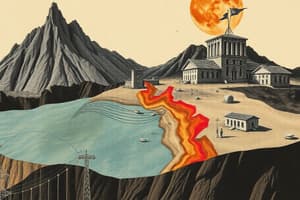Podcast
Questions and Answers
What was the magnitude of the earthquake that occurred on the San Andreas fault?
What was the magnitude of the earthquake that occurred on the San Andreas fault?
- 3
- 2.5
- 0.7 (correct)
- 7.7
How deep was the earthquake that occurred near Geysers, California?
How deep was the earthquake that occurred near Geysers, California?
- 4 kilometers
- 3 kilometers
- 1 kilometer (correct)
- 2 kilometers
Where was the earthquake located that was on the Juan de Fuca plate?
Where was the earthquake located that was on the Juan de Fuca plate?
- On the San Andreas fault
- Southeast of Geysers, California
- Not mentioned in the text (correct)
- Near the interactive map fault report
What did the narrator's sixth grade teacher experience during an earthquake?
What did the narrator's sixth grade teacher experience during an earthquake?
What is the likelihood of a magnitude 7 or larger earthquake happening in the next 30 years in the area near LA?
What is the likelihood of a magnitude 7 or larger earthquake happening in the next 30 years in the area near LA?
What is the name of the fault line that is overdue for a major earthquake?
What is the name of the fault line that is overdue for a major earthquake?
What is the magnitude of the earthquake that the narrator mentions as an example of a huge earthquake?
What is the magnitude of the earthquake that the narrator mentions as an example of a huge earthquake?
Which type of assessment is critical in this class?
Which type of assessment is critical in this class?
What is the result of doing all the homework and averaging it with the exam?
What is the result of doing all the homework and averaging it with the exam?
What is the penalty for late submission of homework?
What is the penalty for late submission of homework?
What is the main factor for success in the class?
What is the main factor for success in the class?
Which fault line in the Bay Area is past due for an earthquake and runs through a heavily populated region?
Which fault line in the Bay Area is past due for an earthquake and runs through a heavily populated region?
What type of fault is the Cascadia Mega Thrust?
What type of fault is the Cascadia Mega Thrust?
What is the potential threat of major earthquakes on the Cascadia Mega Thrust?
What is the potential threat of major earthquakes on the Cascadia Mega Thrust?
What can put pressure on other faults and trigger them to become active?
What can put pressure on other faults and trigger them to become active?
Which type of waves are named after the first waves to arrive during an earthquake?
Which type of waves are named after the first waves to arrive during an earthquake?
What is the difference between the hypocenter and the epicenter of an earthquake?
What is the difference between the hypocenter and the epicenter of an earthquake?
What is the main reason for the Cascadia megathrust being overdue for an earthquake?
What is the main reason for the Cascadia megathrust being overdue for an earthquake?
What is the most significant factor contributing to the substantial damage caused by earthquakes in Mexico City?
What is the most significant factor contributing to the substantial damage caused by earthquakes in Mexico City?
Which earthquake caused the death of around 280,000 people?
Which earthquake caused the death of around 280,000 people?
What is the elastic rebound theory?
What is the elastic rebound theory?
What caused the significant damage during the earthquake in Haiti?
What caused the significant damage during the earthquake in Haiti?
What is the purpose of going under a table during an earthquake?
What is the purpose of going under a table during an earthquake?
What is the best thing to do during an earthquake?
What is the best thing to do during an earthquake?
What produces the largest earthquakes and volcanoes?
What produces the largest earthquakes and volcanoes?
What is the study of earthquake waves called?
What is the study of earthquake waves called?
Flashcards are hidden until you start studying
Study Notes
Earthquakes: Definition, Energy Release, and Impact on Structures
- Earthquakes are the rapid release of energy along faults caused by large-scale motions beneath the crust.
- The energy is released in the form of waves that can be studied using the same physics behind studying water waves.
- The buildup of energy is caused by tectonics and the longer it goes, the bigger the earthquake will be.
- The hypocenter or focus is where the actual break in the rock occurs, and the epicenter is the point directly above the hypocenter on Earth's surface.
- The longer an area is overdue for an earthquake, the larger the earthquake will be.
- The Cascadia megathrust, located between the Juan de Fuca and North American plates, is overdue for an earthquake.
- The energy released during an earthquake travels down the fault line and magnifies in areas built on unconsolidated sediment.
- Mexico City has substantial damage in earthquakes because it is built on lake beds and poorly built structures.
- Japan builds earthquake-proof structures and retrofit buildings to minimize damage during an earthquake.
- The most deadly thing in an earthquake is a poorly built structure.
- The impact of an earthquake can cause water to come shooting out in a process called liquefaction.
- Earthquake waves are named primary waves, secondary waves, and surface waves.
Earthquakes and Seismology
-
Covering your head during an earthquake by going under a table can slow down the impact of falling debris.
-
The best thing to do during an earthquake is to get outside, and in Japan, they have earthquake warning apps that send immediate messages to get outside.
-
Poorly built buildings are one of the biggest killers during earthquakes.
-
Doorways are often framed more securely and can provide some protection during earthquakes.
-
Nuclear bombs can cause earthquakes, and it's safer to cover yourself under something than to pile on top of yourself.
-
Elastic rebound is an analogy for earthquakes, where stress builds up and eventually causes the earthquake.
-
Henry Reid was the first person to identify a fault line during the San Francisco earthquake, before the idea of plate tectonics.
-
Earthquakes are often preceded by foreshocks and followed by aftershocks.
-
Different types of tectonic forces build up stress and strain in rocks, including convergent, transform, and divergent boundaries.
-
Convergent boundaries produce the largest earthquakes and volcanoes, while divergent boundaries produce small shallow earthquakes.
-
Mega thrust faults are the sites of the earth's largest earthquakes, and they can cause tsunamis.
-
Seismology is the study of earthquake waves, and seismographs are instruments that record them. The Richter scale measures the maximum amplitude of the wave to calculate the magnitude of the earthquake.Classroom Q&A Session on Earthquakes
-
The speaker is conducting a Q&A session on earthquakes.
-
Some people are already feeding during the session.
-
The speaker tells them to leave and start the session.
-
The speaker plans to answer five questions during the session.
-
The first question is about the fault and the answer is square.
-
The second question is about the cause of convection currents.
-
The speaker plans to skip the remaining questions and move to the podium.
-
The speaker forgot to discuss a topic and plans to cover it in the next session.
-
The speaker asks if the students completed the homework due yesterday.
-
Triangulation is explained as a method with three sides.
-
The Richter scale is no longer used to record earthquake magnitudes.
-
The speaker apologizes for holding the students for so long and tries to wrap up the session.
Studying That Suits You
Use AI to generate personalized quizzes and flashcards to suit your learning preferences.




